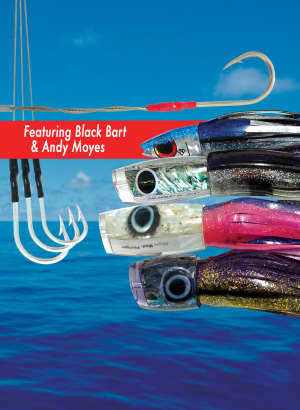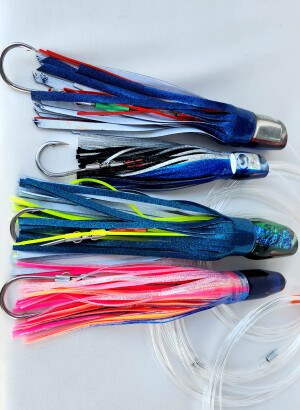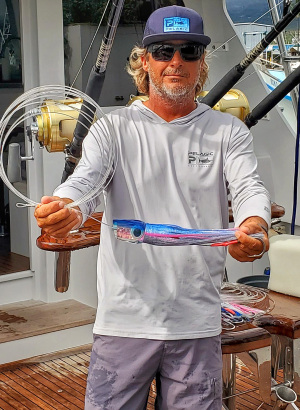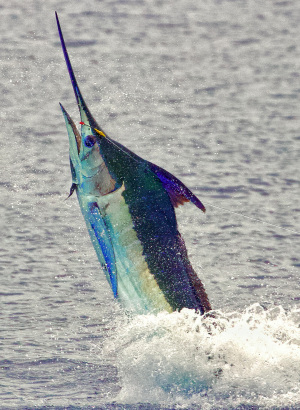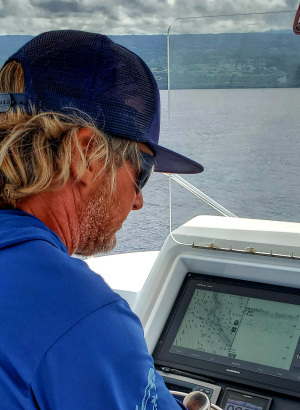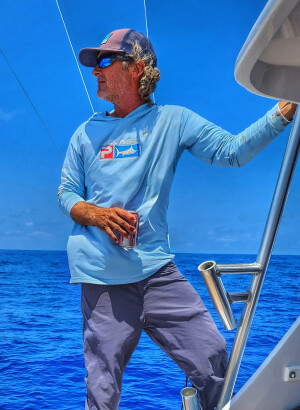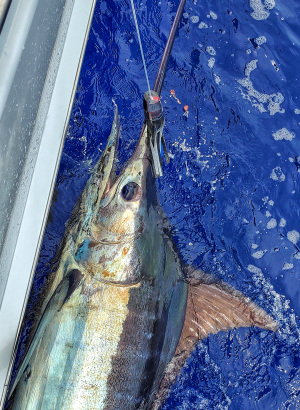Blue Marlin fishing is a fascinating art that requires understanding the fish's behavior, habitat, and techniques. They are apex predators found in tropical and subtropical waters, with their favorite food being flying fish. In The Spread, we provide comprehensive educational videos on techniques, tackle, and strategies to enhance the sport fishing experience and protect the marine environment.
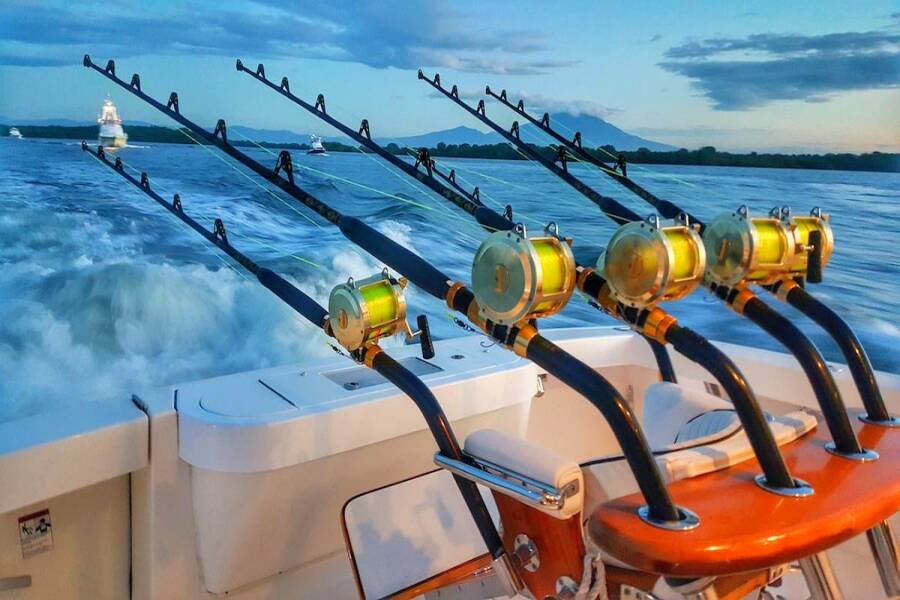
Blue Marlin Fishing – Tips for Success
The deep blue sea is a wondrous world, filled with creatures that capture our imagination and test our skills. Among these magnificent fish is the mighty Blue Marlin, a creature of both beauty and brawn. Blue Marlin fishing is an art that has fascinated fishermen for generations. It is an experience that requires a deep understanding of the fish's behavior, habitat, and a skillful use of tackle and techniques.
At In The Spread, we understand the importance of education for fishermen seeking to improve their skills and knowledge. Our mission is to provide access to some of the world's best fishermen, who are experts in their respective fields. Our comprehensive educational videos provide in-depth coverage of the techniques, tackle, and strategies needed to successfully catch a Blue Marlin. We believe that by sharing knowledge, we can enhance the sport fishing experience and protect our precious marine environment for future generations.
Join us as we explore the exciting world of Blue Marlin fishing and discover the latest tactics, techniques and tackle.
Sarah Mendez, Especialista de PescaThe Blue Marlin
A. Characteristics and Habitat
Blue Marlins are found in the warm, tropical, and subtropical waters of the Atlantic, Pacific, and Indian Oceans. They prefer water temperatures between 70°F and 86°F (21°C and 30°C) and are often found near the surface, down to depths of around 650 feet (200 meters). Some of the most renowned locations for Blue Marlin fishing include the Azores, the Dominican Republic, Puerto Rico, Hawaii (particularly the Kona region), Mauritius, and Cape Verde.
In the Atlantic Ocean, Blue Marlins are highly migratory, with their movements influenced by factors such as water temperature, currents, and prey availability. They are known to undertake extensive north-south migrations, moving towards cooler waters during the summer months and returning to warmer waters in the winter.
Blue Marlins are not only prized for their size and fighting ability but also for their economic value. They support a significant sport fishing industry, with anglers traveling from around the world to participate in marlin fishing tournaments. However, their popularity has also led to concerns about overfishing and the sustainability of Blue Marlin populations. As a result, conservation measures such as catch-and-release practices, minimum size limits, and quotas have been implemented in many regions to help protect these magnificent creatures for future generations.
B. Scientific Classification
The Blue Marlin (Makaira nigricans) is a magnificent and highly sought-after game fish that belongs to the billfish family, Istiophoridae. This family also includes other impressive species such as swordfish (Xiphias gladius), sailfish (Istiophorus platypterus), and other marlin species like the Black Marlin (Istiompax indica) and the Striped Marlin (Kajikia audax).
Blue Marlins are known for their incredible size, speed, and strength. They can grow up to 14 feet (4.3 meters) in length and weigh over 1,985 pounds (900 kg). These powerful fish are built for speed, with a streamlined body, a long, pointed bill (hence the name "billfish"), and a rigid, crescent-shaped tail fin that propels them through the water at speeds of up to 60 mph (97 km/h).
The lifespan of Blue Marlins is impressive, with some individuals known to live up to 27 years in the wild. They are found in tropical and temperate waters of the Atlantic Ocean, Pacific Ocean, and Indian Ocean. Blue Marlins are highly migratory, often covering vast distances in search of food and suitable spawning grounds.
As top predators, Blue Marlins play a crucial role in the marine ecosystem. They feed on a variety of prey, including small fish, squid, and crustaceans. Their unique hunting strategy involves using their long, sharp bill to slash through schools of fish, stunning or injuring their prey before catching and consuming them.
C. Blue Marlin's favorite food
Blue Marlins are indeed opportunistic predators, feeding on a wide variety of prey depending on availability and location. However, one of their favorite and most iconic prey species is the flying fish (family Exocoetidae).
Flying fish are small, ray-finned fish that have evolved the ability to glide above the water's surface for considerable distances to escape predators. They achieve this by launching themselves out of the water at speeds of up to 37 miles per hour (60 kilometers per hour) and extending their large, wing-like pectoral fins to glide through the air, sometimes for distances of over 650 feet (200 meters).
The aerial acrobatics of flying fish make for a thrilling spectacle, but they are not always successful in evading the swift and agile Blue Marlin. These powerful predators often chase flying fish near the surface, using their incredible speed and keen eyesight to track their prey's movements both underwater and in the air.
When a Blue Marlin spots a flying fish, it will rapidly accelerate towards its target, attempting to snatch it out of the air or just as it reenters the water. The marlin's long, sharp bill is particularly useful in these situations, allowing it to effectively slash and stun the flying fish, making it easier to catch and consume.
The pursuit of flying fish by Blue Marlins is not only a testament to the predator-prey relationship but also an example of the complex and dynamic interactions that occur within marine ecosystems. The presence of flying fish in an area can often indicate the likelihood of encountering Blue Marlins, making them an important species for both the ecosystem and the sport fishing industry.
While flying fish may be a favorite prey item for Blue Marlins, it's essential to remember that these apex predators have a diverse diet and will feed on a wide range of species depending on what is available in their environment. Other common prey items include tuna, mackerel, squid, and various other small fish species that inhabit the open ocean.
D. Why is it hard to catch a Marlin?
The Blue Marlin is a notoriously difficult fish to catch, due to its incredible strength and speed. They are known for their long, acrobatic fights, which can last for hours, testing the endurance and skill of even the most experienced angler. Blue Marlin also have a reputation for being finicky eaters, often striking lures or baits in unpredictable ways, which requires an expert knowledge of fishing techniques and strategies.
In our video "Offshore Fishing For Blue Marlin," we share tips for successful Blue Marlin fishing, including setting up a marlin lure spread, lure rigging and boat driving.
Join us in the next section as we explore the techniques and tackle needed to catch a Blue Marlin.
Sarah Mendez, Especialista de PescaBlue Marlin Fishing Techniques
A. Best Time of Year for Marlin Fishing:
The best time of year to catch Blue Marlin is during the summer months, from May to September, which is also known as Marlin season. During this time, the warm waters around Hawaii and other Pacific islands provide the perfect habitat for Blue Marlin. However, you can also find them year-round in certain areas, such as off the coast of Bermuda, the Bahamas and the Virgin Islands in the Atlantic Ocean.
B. Depth to Fish for Blue Marlin:
Blue Marlin are known to swim at various depths, but they tend to stay in deeper waters, around 100-500 feet deep. Anglers use depth sounders and fish finders to locate them in the water.
C. Bait and Lures for Blue Marlin:
There are various types of bait and lures used for Blue Marlin fishing. Live bait, such as tuna or squid, is a popular choice, as well as artificial lures like skirted trolling lures. In The Spread's video "Marlin Fishing | Trolling Lures With Kevin Hibbard" demonstrates the use of skirted trolling lures and how to rig them effectively.
D. Trolling Speed and Lure Spread:
Trolling speed is essential in Blue Marlin fishing. The optimal speed is around 8-10 knots, but this can vary depending on the lure and sea conditions. Anglers also use a spread of lures, which can be varied in distance from the boat and depth, to cover more water and increase the chances of a strike. In The Spread's video "Marlin Fishing | Trolling Kona With Kevin Hibbard" shows how to properly set up the lure spread for maximum effectiveness.
E. Leader and Hook Size:
Blue Marlin are a powerful and strong fish, so anglers need to use strong tackle to catch them. Leaders are typically made from heavy monofilament or fluorocarbon, with a breaking strength of 150-300 pounds. Hook sizes vary, but 10/0 to 12/0 circle hooks are commonly used for Blue Marlin.
F. Tips for Rigging up for Blue Marlin:
In The Spread's video "Marlin Fishing | Tackle With Kevin Hibbard" explains the essential equipment needed for Blue Marlin fishing, including rods, reels, and tackle. Kevin Hibbard provides tips on how to properly rig up and set up your equipment for the best chance of success. Proper rigging can make a significant difference in the success of a fishing trip.
Marlin Fishing Experts
In the world of Blue Marlin fishing, Kevin Hibbard is a name that stands out. With years of experience fishing off the coast of Kona, Hawaii, he has become a renowned expert in the field. Hibbard's videos, including "Marlin Fishing | Kevin Hibbard Kona" and "Marlin Fishing | Trolling Lures With Kevin Hibbard," offer invaluable insights into the art of Blue Marlin fishing.
Learning from experts like Hibbard can provide tremendous benefits for those looking to improve their skills in this challenging sport. Expert anglers have honed their techniques and developed a keen understanding of the nuances of Blue Marlin fishing, and their insights can be invaluable for those looking to catch their first or their hundredth Marlin.
Learning from experts like Hibbard can provide tremendous benefits for those looking to improve their skills in this challenging sport. Expert anglers have honed their techniques and developed a keen understanding of the nuances of Blue Marlin fishing, and their insights can be invaluable for those looking to catch their first or their hundredth Marlin.
Some tips from experts include using pitch baits to attract Blue Marlin, being patient and allowing the fish to take the bait, and having a well-organized and varied lure spread. Learning from experts like Kevin Hibbard through In The Spread's educational videos can help fishermen of all skill levels take their Marlin fishing game to the next level.
Education is a crucial aspect of sport fishing, and it is especially important in the challenging world of Blue Marlin fishing. Understanding the characteristics and habits of Blue Marlin, as well as the best techniques and equipment for catching them, can make all the difference in the success of a fishing trip.
The importance of learning from experts
We have discussed the characteristics and habitat of Blue Marlin, as well as the scientific classification and favorite food of these magnificent fish. We have also delved into the best time of year to fish for Blue Marlin, the depth to fish for them, and the most effective bait and lure spread to use. Additionally, we have touched on the importance of learning from experts like Kevin Hibbard, and the benefits of In The Spread's educational videos.
By subscribing to In The Spread, fishermen can access expert knowledge and learn valuable tips and techniques to improve their Marlin fishing skills. With a deeper understanding of Blue Marlin and the best methods for catching them, fishermen can experience the thrill of landing one of these elusive giants.
Sarah Mendez Especialista de Pesca, In The SpreadUser Reviews




